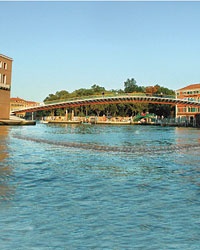 Courtesy of Santiago Calatrava LLC.
Spanish architect Santiago Calatrava has reimagined skylines from Bilbao to Buenos Aires. T+L takes a closer look at his latest project.
Courtesy of Santiago Calatrava LLC.
Spanish architect Santiago Calatrava has reimagined skylines from Bilbao to Buenos Aires. T+L takes a closer look at his latest project.
Santiago Calatrava has made a name for himself as the go-to guy for bridges, having completed 29 of them in 13 countries over the past two decades. This fall, Calatrava’s Quarto Ponte sul Canal Grande is finally being unveiled in Venice after nine years of delays, disputes, and drama. For this contemporary 308-foot-long pedestrian expanse, he deviated from his usual soaring displays of cable networks and pylons, opting instead for a quiet study in tempered glass, Istrian marble, and glazed bronze. The $10.4 million structure was assembled piece by piece, and parts were ferried to the site during low tide so they could pass under the three other bridges that span the Grand Canal. So what does this mean for Venice, a city steeped in history and nostalgia?Perhaps, like other locales that have turned to Calatrava to put themselves on the design map (see below), Venice may find that this new bridge serves as a welcome link to the future.
Marking the start of Calatrava’s international acclaim, the Alamillo was built for the World Expo ’92 and is the architect’s first cable-stayed bridge— in which the angle of the main pylon (a stabilizing mastlike pillar) eliminates the need for any bulky concrete support.
Completed the same year as the Guggenheim, Bilbao’s other starchitect attraction, the Campo Volantin—also called the Zubi Zuri (Basque for white bridge)—is a single arch suspended by more than 80 steel cables.
This three-part pedestrian structure connects the eastern and western docks of Puerto Madero. Said to represent a couple dancing the tango, the bridge has a midsection that swings a full 90 degrees to let boat traffic through.
Calatrava’s first bridge in the United States (a set of three is to be unveiled in Dallas in 2010) is a 700-foot-long, cable-stayed expanse that crosses the Sacramento River. It also accurately tells time one day a year: on June 21, watch the pylon’s shadow move around a huge stone dial at its base at the rate of nearly one foot a minute.
This trio of bridges spans the Hoofdvaart, the main canal running through the booming Haarlemmer meer region, just west of Amsterdam. Resembling musical instruments, the structures are playfully referred to as Harp, Lute, and Lyre by locals.